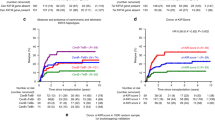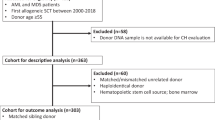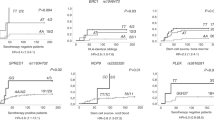Abstract
NK cell activity is tuned by a balance of activating and inhibitory signals transmitted via their respective receptors, including killer immunoglobulin-like receptors (KIRs). The impact of NK cells on graft-versus-leukemia following hematopoietic stem cell transplantation (HSCT) is well established. These effects sometimes lead to GvHD. The link between KIR/HLA interaction and GvHD remains unclear. Herein, we studied the impact of the KIR/HLA interaction on HSCT outcomes in a longitudinal follow-up study of a highly consanguineous HLA-matched related cohort. Peripheral blood DNA was collected from HSCT donor–recipient pairs (n = 87), including 41 AML pairs. KIR and HLA were genotyped and significant results were only measured when matching KIR (donor) with HLA (recipients). GvHD was observed in 47% of patients. KIR2DL1_C2 and 2DS2_C1 (P = 0.02 and 0.04, respectively) matching was associated with an increased incidence of acute GvHD in AML donor–recipient pairs. The rate of chronic GvHD also rose in AML patients who were matched for KIR2DS1_C2 (P = 0.004) and had either KIR2DL2 or KIR2DS2 (P = 0.03). In conclusion, matching of KIR2DL1, 2DS1, and 2DS2 in donors with their HLA-C ligands in recipients is associated with increased GvHD, and holds potential for selection of HSCT donors.
This is a preview of subscription content, access via your institution
Access options
Subscribe to this journal
Receive 12 print issues and online access
$259.00 per year
only $21.58 per issue
Buy this article
- Purchase on Springer Link
- Instant access to full article PDF
Prices may be subject to local taxes which are calculated during checkout






Similar content being viewed by others
References
Saudi Health Council (June 2016). Cancer Incidence Report. http://shc.gov.sa/Ar/HealthCenters/NCC/CancerRegistry/CancerRegistryReports/2013.pdf.
Zittoun RA, Mandelli F, Willemze R, de Witte T, Labar B, Resegotti L, et al. Autologous or allogeneic bone marrow transplantation compared with intensive chemotherapy in acute myelogenous leukemia. European Organization for Research and Treatment of Cancer (EORTC) and the Gruppo Italiano Malattie Ematologiche Maligne dell’Adulto (GIMEMA) Leukemia Cooperative Groups. N Engl J Med. 1995;332:217–23.
Thomas ED, Blume KG. Historical markers in the development of allogeneic hematopoietic cell transplantation. Biol Blood Marrow Transplant. 1999;5:341–6.
Schellekens J, Rozemuller EH, Petersen EJ, van den Tweel JG, Verdonck LF, Tilanus MG. Activating KIRs exert a crucial role on relapse and overall survival after HLA-identical sibling transplantation. Mol Immunol. 2008;45:2255–61.
Petersdorf EW. HLA matching in allogeneic stem cell transplantation. Curr Opin Hematol. 2004;11:386–91.
Horowitz MM, Gale RP, Sondel PM, Goldman JM, Kersey J, Kolb HJ, et al. Graft-versus-leukemia reactions after bone marrow transplantation. Blood. 1990;75:555–62.
Hercend T, Takvorian T, Nowill A, Tantravahi R, Moingeon P, Anderson KC, et al. Characterization of natural killer cells with antileukemia activity following allogeneic bone marrow transplantation. Blood. 1986;67:722–8.
Molldrem JJ, Lee PP, Wang C, Felio K, Kantarjian HM, Champlin RE, et al. Evidence that specific T lymphocytes may participate in the elimination of chronic myelogenous leukemia. Nat Med. 2000;6:1018–23.
Farag SS, Fehniger TA, Ruggeri L, Velardi A, Caligiuri MA. Natural killer cell receptors: new biology and insights into the graft-versus-leukemia effect. Blood. 2002;100:1935–47.
Ruggeri L, Capanni M, Urbani E, Perruccio K, Shlomchik WD, Tosti A, et al. Effectiveness of donor natural killer cell alloreactivity in mismatched hematopoietic transplants. Science. 2002;295:2097–100.
Middleton D, Gonzelez F. The extensive polymorphism of KIR genes. Immunology. 2010;129:8–19.
Yu J, Heller G, Chewning J, Kim S, Yokoyama WM, Hsu KC. Hierarchy of the human natural killer cell response is determined by class and quantity of inhibitory receptors for self-HLA-B and HLA-C ligands. J Immunol. 2007;179:5977–89.
Hsu KC, Chida S, Geraghty DE, Dupont B. The killer cell immunoglobulin-like receptor (KIR) genomic region: gene-order, haplotypes and allelic polymorphism. Immunol Rev. 2002;190:40–52.
Hsu KC, Liu XR, Selvakumar A, Mickelson E, O’Reilly RJ, Dupont B. Killer Ig-like receptor haplotype analysis by gene content: evidence for genomic diversity with a minimum of six basic framework haplotypes, each with multiple subsets. J Immunol. 2002;169:5118–29.
Uhrberg M, Parham P, Wernet P. Definition of gene content for nine common group B haplotypes of the Caucasoid population: KIR haplotypes contain between seven and eleven KIR genes. Immunogenetics. 2002;54:221–9.
Du Z, Gjertson DW, Reed EF, Rajalingam R. Receptor-ligand analyses define minimal killer cell Ig-like receptor (KIR) in humans. Immunogenetics. 2007;59:1–15.
Witt CS, Christiansen FT. The relevance of natural killer cell human leucocyte antigen epitopes and killer cell immunoglobulin-like receptors in bone marrow transplantation. Vox Sang. 2006;90:10–20.
Impola U, Turpeinen H, Alakulppi N, Linjama T, Volin L, Niittyvuopio R. Donor haplotype B of NK KIR receptor reduces the relapse risk in HLA-identical sibling hematopoietic stem cell transplantation of AML patients. Front Immunol. 2014;5:405.
Bishara A, De Santis D, Witt CC, Brautbar C, Christiansen FT, Or R, et al. The beneficial role of inhibitory KIR genes of HLA class I NK epitopes in haploidentically mismatched stem cell allografts may be masked by residual donor-alloreactive T cells causing GVHD. Tissue Antigens. 2004;63:204–11.
Beelen DW, Ottinger HD, Ferencik S, Elmaagacli AH, Peceny R, Trenschel R, et al. Genotypic inhibitory killer immunoglobulin-like receptor ligand incompatibility enhances the long-term antileukemic effect of unmodified allogeneic hematopoietic stem cell transplantation in patients with myeloid leukemias. Blood. 2005;105:2594–600.
Sobecks RM, Ball EJ, Maciejewski JP, Rybicki LA, Brown S, Kalaycio M, et al. Survival of AML patients receiving HLA-matched sibling donor allogeneic bone marrow transplantation correlates with HLA-Cw ligand groups for killer immunoglobulin-like receptors. Bone Marrow Transplant. 2007;39:417–24.
De Santis D, Bishara A, Witt CS, Nagler A, Brautbar C, Slavin S, et al. Natural killer cell HLA-C epitopes and killer cell immunoglobulin-like receptors both influence outcome of mismatched unrelated donor bone marrow transplants. Tissue Antigens. 2005;65:519–28.
Gaafar A, Sheereen A, Iqneibi A, Mohamed G, Al Sulaiman A, Turpeinen H, et al. Killer cell immunoglobulin-like receptor gene diversity in the Saudi population. Mol Biol Rep. 2011;38:2603–10.
Gumperz JE, Parham P. The enigma of the natural killer cell. Nature. 1995;378:245–8.
Boyington JC, Sun PD. A structural perspective on MHC class I recognition by killer cell immunoglobulin-like receptors. Mol Immunol. 2002;38:1007–21.
Schellekens J, Rozemuller EH, Borst HP, Otten HG, van den Tweel JG, Tilanus MG. NK-KIR ligand identification: a quick Q-PCR approach for HLA-C epitope typing. Tissue Antigens. 2007;69:334–7.
Kroger N, Binder T, Zabelina T, Wolschke C, Schieder H, Renges H, et al. Low number of donor activating killer immunoglobulin-like receptors (KIR) genes but not KIR-ligand mismatch prevents relapse and improves disease-free survival in leukemia patients after in vivo T-cell depleted unrelated stem cell transplantation. Transplantation. 2006;82:1024–30.
Ruggeri L, Capanni M, Casucci M, Volpi I, Tosti A, Perruccio K, et al. Role of natural killer cell alloreactivity in HLA-mismatched hematopoietic stem cell transplantation. Blood. 1999;94:333–9.
Gagne K, Brizard G, Gueglio B, Milpied N, Herry P, Bonneville F, et al. Relevance of KIR gene polymorphisms in bone marrow transplantation outcome. Hum Immunol. 2002;63:271–80.
Venstrom JM, Pittari G, Gooley TA, Chewning JH, Spellman S, Haagenson M, et al. HLA-C-dependent prevention of leukemia relapse by donor activating KIR2DS1. N Engl J Med. 2012;367:805–16.
Cook MA, Milligan DW, Fegan CD, Darbyshire PJ, Mahendra P, Craddock CF, et al. The impact of donor KIR and patient HLA-C genotypes on outcome following HLA-identical sibling hematopoietic stem cell transplantation for myeloid leukemia. Blood. 2004;103:1521–6.
Hsu KC, Keever-Taylor CA, Wilton A, Pinto C, Heller G, Arkun K, et al. Improved outcome in HLA-identical sibling hematopoietic stem-cell transplantation for acute myelogenous leukemia predicted by KIR and HLA genotypes. Blood. 2005;105:4878–84.
Parham P. MHC class I molecules and KIRs in human history, health and survival. Nat Rev Immunol. 2005;5:201–14.
McQueen KL, Dorighi KM, Guethlein LA, Wong R, Sanjanwala B, Parham P. Donor-recipient combinations of group A and B KIR haplotypes and HLA class I ligand affect the outcome of HLA-matched, sibling donor hematopoietic cell transplantation. Hum Immunol. 2007;68:309–23.
Schellekens J, Rozemuller EH, Petersen EJ, van den Tweel JG, Verdonck LF, Tilanus MG. Patients benefit from the addition of KIR repertoire data to the donor selection procedure for unrelated haematopoietic stem cell transplantation. Mol Immunol. 2008;45:981–9.
Acknowledgements
The authors would like to thank Miss Reguia Belkhedim and her team for coordinating patient consent and sample collection. Prof. Hannu Turpeinen is kindly acknowledged for critically reviewing our manuscript. Finally, we would like to thank the HSCT recipients and donors for their participation in this study.
Funding:
This study was approved and funded by King Abdul-Aziz City for Science and Technology, Riyadh, Saudi Arabia, as part of grant number AT-26-03 and by RAC # 2051 001, King Faisal Specialist Hospital and Research Centre.
Author contributions:
AG: Conception and design, supervised laboratory investigations, interpretation/analysis and presentation of data and manuscript writing. AS: Performed KIR typing and preliminary analysis of immunogenetics data and participated in manuscript editing. AE: Performed statistical analysis. AI: Assisted AG and AS in performing HLA typing by high resolution, and contributed to data analysis. NC, SYM, SM, AH, MS, FA, RE, and SH: screened and followed up the patients and critically reviewed the manuscript. TE: assisted AE in statistical analysis, presentation of the data, and revising the manuscript critically for important intellectual content. RY: provided blood samples and clinical data. MA: participated in the study design, critically reviewed the manuscript for intellectual and clinical contents, and participated in manuscript editing. KA: Principal investigator seeks and obtained funds from KACST for the study, also conception, design, and final approval of manuscript.
Author information
Authors and Affiliations
Corresponding authors
Ethics declarations
Conflict of interest:
The authors declare that they have no conflict of interest.
Rights and permissions
About this article
Cite this article
Gaafar, A., Sheereen, A., Almohareb, F. et al. Prognostic role of KIR genes and HLA-C after hematopoietic stem cell transplantation in a patient cohort with acute myeloid leukemia from a consanguineous community. Bone Marrow Transplant 53, 1170–1179 (2018). https://doi.org/10.1038/s41409-018-0123-7
Received:
Revised:
Accepted:
Published:
Issue Date:
DOI: https://doi.org/10.1038/s41409-018-0123-7



